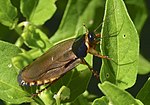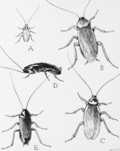Parthenogenesis is a mode of asexual reproduction in which offspring are produced by females without the genetic contribution of a male. Among all the... 18 KB (2,203 words) - 22:06, 17 March 2024 |
 | Asexual reproduction (section Parthenogenesis) asexually. In vertebrates, the most common form of asexual reproduction is parthenogenesis, which is typically used as an alternative to sexual reproduction in... 40 KB (4,283 words) - 06:53, 22 April 2024 |
 | Squamata (section Facultative parthenogenesis) facultative parthenogenesis; they are capable of switching from a sexual mode of reproduction to an asexual mode. The type of parthenogenesis that likely... 60 KB (3,658 words) - 05:08, 27 April 2024 |
 | Thelytoky (redirect from Thelytokous parthenogenesis) Thelytoky (from the Greek thēlys "female" and tokos "birth") is a type of parthenogenesis and is the absence of mating and subsequent production of all female... 16 KB (1,821 words) - 20:48, 27 February 2024 |
 | Snake (section Facultative parthenogenesis) is common for neck-biting to occur while the snakes are entwined. Parthenogenesis is a natural form of reproduction in which growth and development of... 150 KB (15,043 words) - 02:22, 27 April 2024 |
 | Surinam cockroach (section Parthenogenesis) populations are almost exclusively female, and it reproduces through parthenogenesis, having evolved several clonal strains from its sexual progenitor P... 14 KB (1,571 words) - 03:58, 27 April 2023 |
Parthenogenesis is a form of reproduction where eggs develop without fertilization, resulting in unisexual species. This phenomenon is closely related... 11 KB (1,351 words) - 22:06, 17 March 2024 |
 | Hemiptera (section Parthenogenesis and viviparity) young nymphs that somewhat resemble adults. Many aphids are capable of parthenogenesis, producing young from unfertilised eggs; this helps them to reproduce... 64 KB (6,449 words) - 06:19, 30 April 2024 |
 | Daphnia pulex (section Parthenogenesis) Like most other Daphnia species, D. pulex reproduces by cyclical parthenogenesis, alternating between sexual and asexual reproduction. D. pulex occurs... 13 KB (1,403 words) - 23:32, 3 December 2023 |
 | Vertebrate (section Parthenogenesis) that allow them to breed independently or to join unrelated groups. Parthenogenesis is a natural form of reproduction in which growth and development of... 77 KB (7,023 words) - 02:52, 10 April 2024 |
 | Komodo dragon (category Vertebrate parthenogenesis) Wichita, Kansas, became the first zoo in the Americas to document parthenogenesis in Komodo dragons. The zoo has two adult female Komodo dragons, one... 68 KB (7,864 words) - 04:49, 28 April 2024 |
 | Cockroach (section Parthenogenesis) Daimon, T. (2019). "First molecular genetic evidence for automictic parthenogenesis in cockroaches". Insect Science. 26 (4): 649–655. Bibcode:2019InsSc... 78 KB (8,298 words) - 05:12, 29 April 2024 |
 | one to two weeks until the young finishes their first shed cycle. Parthenogenesis is a natural form of reproduction in which growth and development of... 62 KB (7,299 words) - 11:02, 25 April 2024 |
 | Fish reproduction (section Parthenogenesis) Parthenogenesis is a form of asexual reproduction in which growth and development of embryos occur without fertilization. In animals, parthenogenesis... 46 KB (5,606 words) - 16:32, 26 April 2024 |
 | New Mexico whiptail (category Vertebrate parthenogenesis) differentiation). Parthenogenesis allows the all-female population to reproduce. This combination of interspecific hybridization and parthenogenesis exists as... 6 KB (535 words) - 22:26, 26 April 2024 |
 | Cloning (section Parthenogenesis) this reproduction of an organism by itself without a mate is known as parthenogenesis. In the field of biotechnology, cloning is the process of creating... 106 KB (11,415 words) - 19:48, 27 April 2024 |
 | sometimes claimed to be the equivalent of parthenogenesis in animals. That is incorrect because parthenogenesis is a method of asexual reproduction, with... 8 KB (977 words) - 04:47, 7 March 2024 |
 | Fertilisation (section Parthenogenesis) Organisms that normally reproduce sexually can also reproduce via parthenogenesis, wherein an unfertilised female gamete produces viable offspring. These... 45 KB (5,197 words) - 10:22, 20 April 2024 |
 | fragmentation; budding, such as in Hydra and other cnidarians; or parthenogenesis, where fertile eggs are produced without mating, such as in aphids... 125 KB (11,122 words) - 19:22, 27 April 2024 |
 | Brine shrimp (section Parthenogenesis) nauplius larvae are less than 0.4 mm in length when they first hatch. Parthenogenesis is a natural form of reproduction in which growth and development of... 29 KB (3,167 words) - 06:17, 30 April 2024 |
to Hesiod's Theogony, were the offspring of Eris (Strife) through parthenogenesis. Hesiod, Theogony 229. Hesiod, Theogony, in The Homeric Hymns and Homerica... 1 KB (66 words) - 21:34, 13 March 2024 |
Intragenomic conflict refers to the evolutionary phenomenon where genes have phenotypic effects that promote their own transmission in detriment of the... 19 KB (2,217 words) - 00:48, 24 August 2023 |








